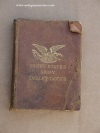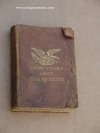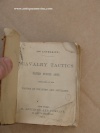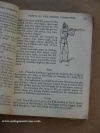
|
1874 US Army Cavalry Tactics Manual ID'd to 7th Mounted Infantry Officer Who Fought in 1876 Yellowstone Campaign in Montana |
This is a fascinating piece of United States history. We purchased this 1874-dated US Army Cavalry Tactics manual a couple of years ago and were finally able to find some information about its original owner. This manual has a printing date of 1874, by D. Appleton and Company, New York. It was issued to an officer who fought in the Montana "Yellowstone Campaign", March-October of 1876 during the Great Sioux War, 1876-77. Obviously, the most famous event to occur during the Yellowstone Campaign of 1876 was the Battle of Little Bighorn on June 25, when Colonel George Armstrong Custer's 7th Cavalry attacked a large village of Sioux and Cheyenne warriors, resulting in those under his command being completely overrun and wiped out. Inside the cover is the original officer's name inscribed inside the: Received June 25, 1874WJ Reed 1st Lieut. Co. E 7th Inf. Commanding Company The majority of our research has been found on ancestry.com's link to the National Archives as well as other information obtained from other websites. On camp and fort reports in the National Archives, William Reed is listed under a variety of names such as WJ Reed, WI Reed, William J Reed, and sometimes William I Reed (depending on a researcher's interpretation of how "I" or "J" is written back in the 19th century. What we know is that Reed was originally from California, was almost a continuous professional soldier throughout his adult life, had some ups and downs, and served in the US 7th Infantry for almost the last twenty years of his career. During his time in Company E he both served and commanded alongside some very capable and heroic men including Colonel John Gibbon. Three of his men were Medal of Honor recipients. We were also able to locate two photographs of Reed on the frontier of Fort Steele, Wyoming during the last phase of his career. Here is a timeline of Lieutenant William J. Reed's career in the US Army and Company E of the 7th Infantry: Sept. 1851 Possible match of a Private William Reed serving as a Private in the 1st Dragoons at Sonoma Barracks On the 1st of March, 1872, Congress set apart a tract of land in Montana and Wyoming, fifty-five by sixty-five miles square, about the head of the Yellowstone River, to be called the Yellowstone National Park, and the survey begun in 1871 by Hayden was continued this year in the Gallatin and upper Yellowstone valleys - from the east fork of the Yellowstone to the mining district on Clarke fork; in the Geyser basins, and on Madison River. This survey was not in the route of the raiding Sioux, and escaped any conflict with the common enemy. But a railroad surveying expedition of 300 men under Colonel E. Baker was attacked near the mouth of Pryor fork by a larger number of Sioux and Cheyennes, losing one man killed, and having five wounded. The fighting lasted for several hours, and the Indians, though armed with repeating rifles, lost heavily in men and horses. More fortunate was a pleasure excursion projected by Durfee and Peck of the North-western Transportation Company, which thus early invited travel over the route pursued by them from Chicago westward. The excursionists took boats, built for the occasion, at Sioux City, and proceeded up the Missouri and the Yellowstone as far as Powder River, where a wagon-train was fitted up, and escorted by a strong military guard and reliable guides to Yellowstone park. General Sheridan detailed General Gibbon to accompany this notable excursion - the first purely pleasure-seeking company to visit the nation's reserve. Jan. 26, 1873 Detached Service Commands Escort to Helena, Montana...(the post report was difficult to read but Reed's assignment makes mention of: "RG Walker"..."Mayor?" , "Payroll?") December 13, 1873 thru January 20, 1874 In Arrest (Report makes no mention of infraction) August 6, 1874 Transferred to Fort Baker, Montana August 4-30, 1874 On Detached Service to Alcatraz Island, CA per Special Order No. 117 Hd Qrs FSMTCS February 19-24, 1874 "In Pursuit of Deserters" 3-30-1874 thru 6-23-1874 In Command of Company E -- Assigned to form part of escort to "Maclays Train" ..."New Muscle Shell Road to Carroll" June 25, 1874 The Date Lt. WJ Reed receives and inscribes this Cavalry Tactics Manual (just back from three months in the field, it appears Reed is being given a new assignment for Mounted Infantry....hence the receipt of this Cavalry Manual). August 6, 1874 Transferred to Camp Baker September 1, 1874 Commanding Detached Mounted Infantry August 11, 1874 Designated AAQM for Camp Baker (Assistant Army Quartermaster) December 10, 1874 Designated ACS for Camp Baker (Assistant Commissary and Subsistence) April 30, 1875 Listed as "Casually at Post" and is "Colonel John Gibbon http://en.wikipedia.org/wiki/John_Gibbon, Capt. Charles Gilbert, and Lt. Jacobs" March 5-14, 1876 Detached Service to Helena, Montana March 7, 1876 Redesignated as ACS Head for Camp Baker March 17, 1876 Company E under command of Lieutenant Clifford leaves on detached service from Camp Baker as part of Colonel Gibbon's force on the Yellowstone Campaign. Lt. Reed who's also the co-commander of Company E is now in charge of Quartermaster, Chief of Staff, Commissary, and Mounted Infantry and stays at Camp Baker, Montana. June 25, 1876 Colonel Custer's 7th Cavalry is wiped out at The Battle of Little Bighorn by Sioux and Cheyenne http://en.wikipedia.org/wiki/Battle_of_the_Little_Bighorn June 26, 1876 Colonel Gibbon's force -- including 7th Infantry Company E under Lt. Clifford arrives at Little Bighorn to rescue the remaining 7th Cavalry units under Major Reno. The sole surviving "Army" witness to the Custer defeat is a young Crow Scout from the 7th Infantry nicknamed "Curly" who had been assigned to 7th Cavalry just days prior to its demise. http://en.wikipedia.org/wiki/Curly Note: Dustin Hoffman's character "Curly" in the 1970 movie "Little Big Man" is partially based on him. July 9, 1876 Following two aborted attempts by scouts to deliver an urgent message through hostile territory to General Crook in Wyoming, General Terry assigns three volunteers, Private James Bell, William Evans, and Benjamin Stewart, all from Company E 7th Infantry US Army to reach Crook's forces. All three are awarded the Congressional Medal of Honor. See http://en.wikipedia.org/wiki/James_Bell_(Medal_of_Honor) These are Lieutenant Reed's and Clifford's men. July 27, 1876 Lieutenant Reed is relieved of his post commands at Camp Baker and assigned to the Yellowstone Expedition in command of the US Army 7th Mounted Infantry. Though Reed is still part of Company E, it appears the Mounted Infantry is a special unit comprised of soldiers from various companies within the 7th infantry. July 31, 1876 Lieutenant Reed departs Camp Baker to participate in Yellowstone Campaign. October 12, 1876 Returns to Camp Baker from Yellowstone Campaign and resumes duties as AAQM and ACS for Post. October 29, 1876 Must appear as witness to General Court Martial held at Fort Shaw January 12, 1877 In Arrest...released of duties as AAQM and ACS of Post January 26, 1877 Arrived at Fort Shaw from Camp Baker in Arrest. Undergoing trial by Gen Court Martial March 15-27, 1877 Sent back to Camp Baker April 1877 Sent back to Fort Shaw May 5-1877 Transferred back to Camp Baker in Arrest (still under arrest) August 6-1877 Suspended from Rank for two years without pay excluding $75/month November 11, 1877 Given Leave of Absence on Sick Disability April 9, 1878 Letter from War Department dismissing at least one of the charges against Reed: http://www.worthpoint.com/worthopedia/letter-to-war-dept-lieut-w-i-reed-7th-infanty January through August 1878 Listed as Under Arrest but absent on sick leave. Camp Baker Post records make mention of possible correspondence from Reed from San Franscisco, CA and Lincoln County Nevada. October 1878 7th Infantry Co. E transferred to Fort Snelling in Minnesota Territory -- Reed still listed as absent on sick leave June 23, 1880 Reed rejoins 7th Infantry at Fort Snelling, assigned to Co. H June 28, 1880 Leaves for Fort Buford, Dakota Territory Feb. 23, 1883 Promoted to Captain 1885 Photograph of Captain Reed with officers in Wyoming (Reed is standing 2nd from rt. on back row) http://gallery.unl.edu/picinfo/3201.html 1887 Photograph of Captain Reed and Company E 7th Infantry at Fort Steele, Wyoming (Reed is officer seated on right in front of the enlisted soldiers) http://www.cowanauctions.com/auctions/item.aspx?ItemId=53341 Apr. 23, 1889 Retired from US Army as Captain of Company E 7th Infantry 1910 There is mention of a retired officer named "William Reed" at Walter Reed Hospital in Washington, DC. This is all the information we have on Lieutenant Reed at this time. Obviously, there are many more questions that we'd like to answer about Reed...particularly the reasons behind his two arrests and what happened to him thereafter. What we do know is that he served for much of the 1870's in the 7th Infantry in Montana participating in a number of dangerous assignments including the latter half of the Yellowstone Campaign just after Custer's defeat at Little Bighorn. Of further interest is that Reed commanded three soldiers who earned the Medal of Honor during the aftermath of Little Bighorn and served alongside officers like Colonel Gibbon and Clifford who rescued Reno's forces. Some interesting observations about this manual: At least one or more pages appear to have been bookmarked by Lt Reed. The one page with its corner turned gives instructions on how to dismount from horseback and fight on foot as skirmishers. This seems to fit Reed's assignment as commander of a unit of Mounted Infantry. Another mystery is that this book has not one but two names. The second name on the page opposite of Reed's appears to be "Lt. Stedden" 18/8/1909. Could this manual have been a gift to another officer towards the end of Reed's life around the time a retired officer named William Reed is at Walter Reed hospital circa 1910? Overall Condition is Good...especially for a paper item issued to a Mounted Infantry officer during the Indian Wars. The book is complete with no pages missing. It's a small manual measuring 4.75" x 3.5" x 1" that appears to have been made for use in the field...specifically on horseback. There appears to have once been a small metal clasp attached to the front and rear cover of the manual to keep it secure which is now missing. You can see the indention made by the clasp on the covers and that it was attached with three prongs. A rare book with some fascinating ties to the Indian Wars including action in the Yellowstone campaign after the Battle of Little Bighorn. This is probably one of the only surviving cavalry manuals that can be connected to the fighting in Montana during the summer of 1876. Much much more research could be done on this manual and Captain Reed's long career in the US Army. Item# 1511 $1,500 |
 |
 |
 |
 |
 |
 |
 |